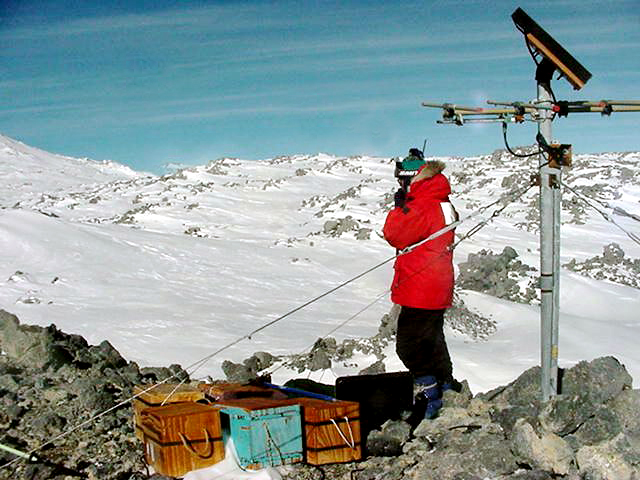
Photo Credit: Jean Pennycook/MEVO Web site |
Scientist Rick Aster stands next to a seismic station on Mount Erebus during a previous field season. A new array of seismometers installed this season will record and measure energy waves created by small explosions. The science team is also using smaller, temporary seismometers for their work. |
Seismometers at crater rim monitor the 'heartbeat' of the volcano
The process begins with drilling a hole, worked performed by Jay Kyne from the Ice Core and Drilling Services at the University of Wisconsin-Madison. Using an ice core-drill, he made 15-centimeter-wide holes up to 12 meters deep into the ice, at three locations of interest for the project.
The explosive used by the blasters, led by Marty Reed, is ammonium nitrate/fuel oil (ANFO), an explosive fertilizer mix. Snelson said the fertilizer is environmentally safe and normally stable unless deliberately detonated.
The explosives team placed a small amount of ANFO in the bottom of each hole to serve as a bed for the detonators and boosters (that, as the name implies, gives a boost to ignite the ANFO), then poured several more sacks of ANFO into the holes, according to Reed.
“The amount of explosives was in relation to the depth of the holes,” Reed explained. “In some areas, where rock might be encountered, drilling would stop — the reason the drilling machine was designed for cutting through ice and not rock.”
The holes and the blasts have only a negligible and short-lived impact on Erebus’s environment, and the explosive work conforms to strict safety standards, according to National Science Foundation (NSF) officials.
Reed’s team often supports science and construction projects throughout the summer season. For example, they work with marine biologists to create holes in sea ice for scuba diving if the project is too far away from McMurdo Station to use heavy equipment to drill the holes.
“When we are with geologists, the projects vary from the seismic work like the current Mount Erebus project or fracturing siltstone for removing plant and animal fossils like on Beardmore Glacier,” Reed said.
“The Beardmore Glacier camp was a fantastic adventure in 2003,” he added. That season, a science team led by Allan Ashworth found various plant and animal fossils on Oliver Bluffs and Bill Hammer’s group collected dinosaurs specimens on Mount Kirkpatrick.
This was the first time the blasters worked on Mount Erebus, he said. “Just being on a volcano in Antarctica is unusual; using explosives as a tool for the research just adds to the novelty,” Reed said.
A short film clip of one detonation recorded a dull thud, a muffled version of the explosion one hears on a ski mountain to control avalanches. A small geyser of snow shot into the air to mark where the team had set the ANFO. A few whoops of excitement followed by some off-camera voices.
Snelson said the technique is still a little rough, as the explosion shouldn’t have disturbed the surface snow. Instead, the explosion should have been contained to maximize the seismic energy produced. The team brought about 850 kilograms of ANFO to Erebus this year. In future seasons, she said, they plan to use about ten times that amount — still well below the annual limits dictated by environmental protocols.
The seismic work itself is not new to how Kyle’s team monitors the volcano. Several permanent seismometers sit at the crater rim — though the number was reduced by one in March 2007 when a “bomb,” a hot rock launched from the open lava lake, crushed the instrument.
Most of the time, the instruments work passively, picking up the sound waves from distant earthquakes, or the rumblings and grumblings of Erebus, what Kyle refers to as “monitoring the heartbeat of the volcano.”
Tom Wagner, program manager for Earth Sciences in the Office of Polar Programs at the National Science Foundation (NSF), said the project will answer a fundamental question about volcanism — the nature of that deep plumbing system — that he is surprised hasn’t already been discovered.
“If you want to understand why [volcanoes] undergo explosive eruptions or predict when they are going to erupt, this is the sort of fundamental information that you need,” he said.
“And it’s profoundly important to do this work at Erebus because of the lava lake, which is a window into the plumbing system,” Wagner added. “By combining all of the information on gas release, heat exchange, and magma history with the seismology, we have a chance to develop a picture of how volcanoes work in way that cannot be done elsewhere on earth.
“This is one of the most exciting projects we have going on for the next couple of years.”
NSF-funded research in this story: Phil Kyle, New Mexico Institute of Mining and Technology.
Back 1 2





